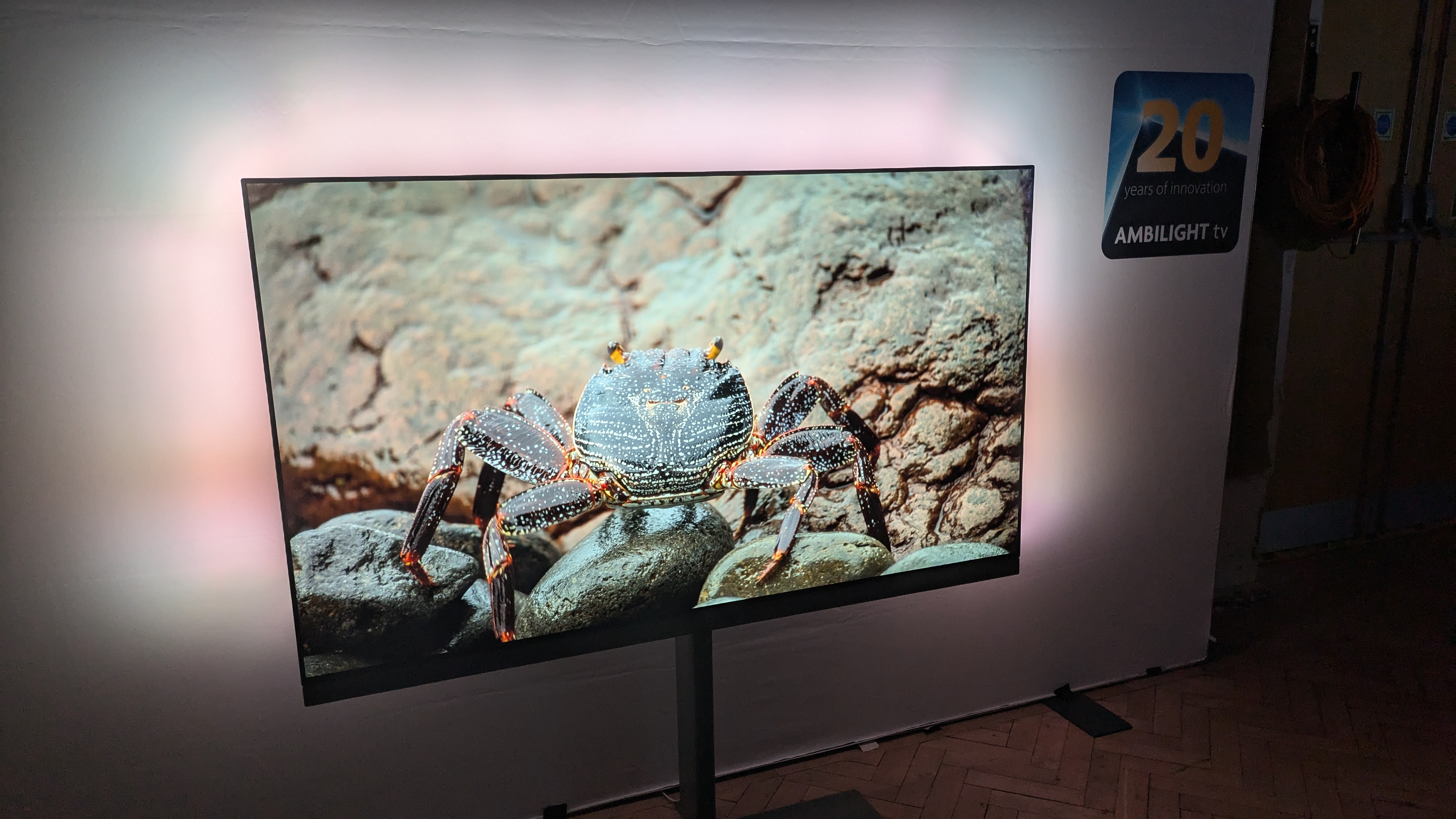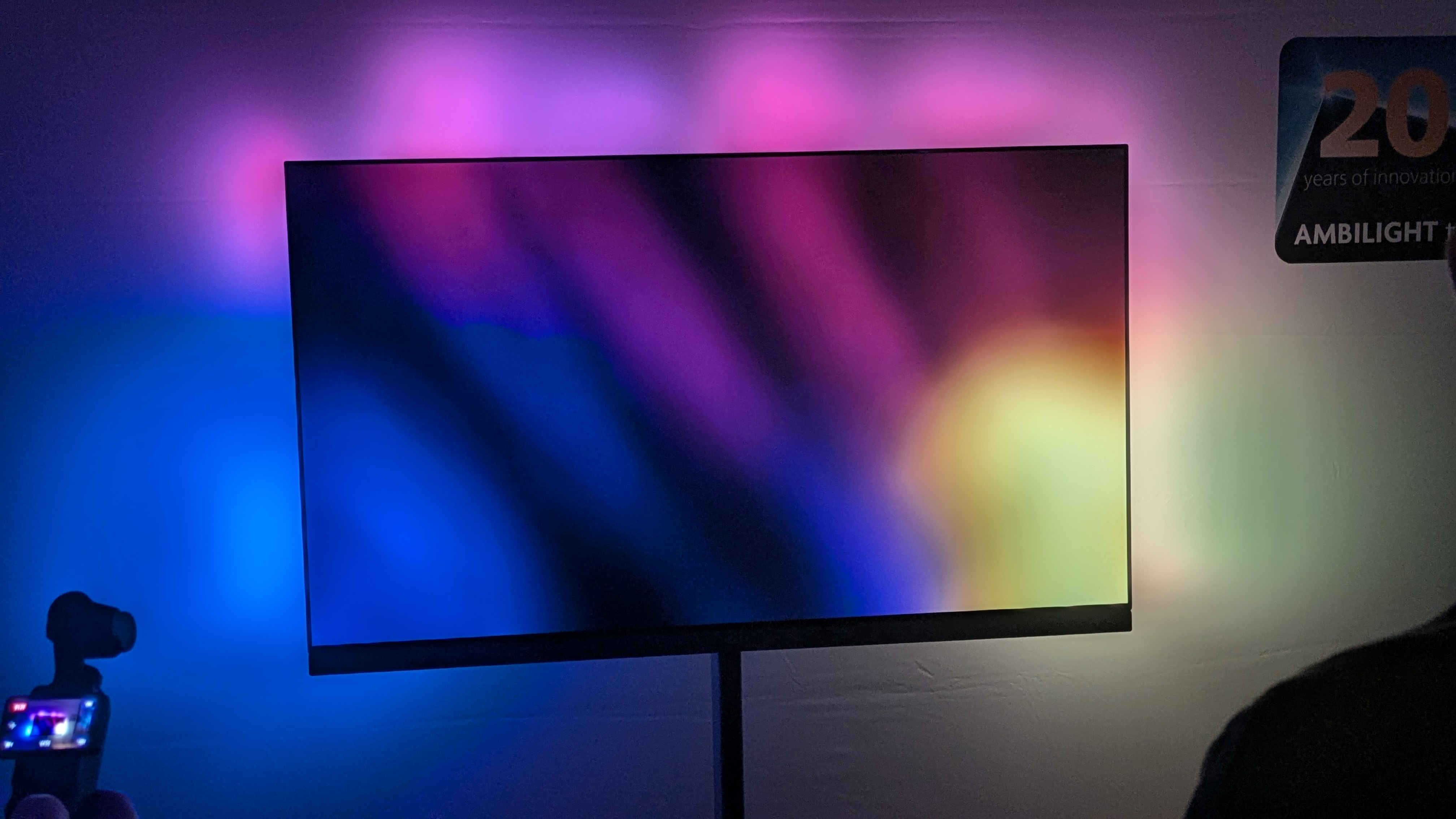I saw Philips' ultra-bright new OLED TV with awesome built-in Dolby Atmos sound – and it's really going to shake things up
Philips TV outdoes itself

Philips has unveiled the full details of its 2024 flagship OLED TV, the Philips OLED+959. It will be available in a 65-inch size only, with a launch price of £3,999. First models are set to be shipped in mid-October 2024. Philips' TVs sadly aren't available in the US, so the OLED+959 is a UK only set.
I recently saw the OLED+959 in action at the legendary Abbey Road Studios in London, and you can read about what I saw below – but first the specs.
The OLED+959 uses a META 2.0 OLED panel with micro lens array (MLA) tech for added brightness – the same one found in one of the best TVs of this year, the LG G4, although Philips claims the OLED+959 will hit 3,000 nits of peak brightness, which is way beyond what the LG manages. It also uses a ‘Dual Engine’ version of Philips’ 8th Generation P5 AI processor, an enhanced version of the processor found in the excellent Philips OLED909 and Philips OLED809.
This processor comes packed with AI features, including AI Machine Learn Sharpness V2 for sharper textures and details; Ambient Intelligence V3, which optimises HDR performance to match the TV’s Ambilight feature; and Smart Bit Enhancement V3, which boosts 8-bit video colour to a 14-bit level to correct for banding and contrast loss.
There’s also an AI Sports Optimisation mode that detects when football is on screen and optimises processing to reduce judder and improve picture clarity. Philips has confirmed that the mode is currently exclusive to football but will look to expand to other sports in the future.
The OLED+959 also includes Ambilight Plus, an upgraded version of its Ambilight tech that enables 192 lighting zones for more dynamic, vibrant and faster response to what's on-screen.
Elsewhere, the OLED+959 features a 5.1.2-channel Bowers & Wilkins speaker array. This uses 18 drivers totalling 102W of power output, with front left, centre and right channels, two additional side-firing channels, two up-firing channels and a rear subwoofer.
Sign up for breaking news, reviews, opinion, top tech deals, and more.
The OLED+959 also has four HDMI ports, with two HDMI 2.1 plugs that support a plethora of gaming features such as 4K 144Hz, Dolby Vision gaming, VRR (including AMD FreeSync Premium Pro and Nvidia G-Sync), HGiG and ALLM. Philips claims a 5ms input lag at 120Hz and 13ms at 60Hz.
The OLED+959 uses Google TV as its smart TV platform, and there will be no Freeview Play with its associated apps such as BBC iPlayer and ITVX but this can be solved by plugging in an Amazon Fire Stick or other streaming device.
Brighter pictures and Ambilight

For Philips’ demo, the OLED+959 was initially shown next to the step-down OLED909 to showcase its Dual Engine P5 processor. The TVs were both in Crystal Clear picture mode. This is Philips’ version of Vivid/Dynamic, a mode we would typically recommend against, opting instead for the more accurate Filmmaker or Home Cinema modes. However, Crystal Clear mode looked good on the OLED+959, with the Dual Engine processor enhancing details with a high level of refinement. Colours were still over-saturated in places, but it was nonetheless watchable.
I also received a demo of the AI Sports Optimisation feature, which did a good job of reducing the halo effect around players of compressed video while lowering the motion judder not only on the pitch, but in panning camera shots across the crowd.
Next up was a demo of the new Ambilight Plus technology. As you might expect, Ambilight Plus goes one step further than standard Ambilight, adding more brightness and saturation to the TV’s coloured backlight, plus a more dynamic effect through increased motion. In the demo, a cyclist on a bright, neon-clad bicycle tore through a forest, and Ambilight Plus conveyed a strong sense of movement in the lights and an added sense of immersion even beyond what you normally get from the tech.
TV sound elevated

The most exciting OLED+959 demo was of its built-in Bowers & Wilkins 5.1.2-channel speaker system While the best soundbars often improve on a TV’s built-in sound, some of the best TVs for sound such as the Sony Bravia 9 and Panasonic MZ2000 are good enough that they don’t need a soundbar. From what I heard during this event, the OLED+959, too, will enter that category.
Starting with a Dolby Atmos track, So We Find Ourselves by Fink, the OLED+959 demonstrated plenty of detail, clarity and a wide soundstage. It was a rare experience to hear a TV playing music so accurately, with the OLED+959 easily conveying the song’s delicate piano and warm bass. On a more bass-heavy electronic track, the OLED+959 showcased thumping bass and pulsing synths that again wouldn’t be out of place on a modest hi-fi system.
But it was during movies where the OLED+959 came to life. Using the empty bar scene from Blade Runner: 2049, where Joe speaks to Deckard properly for the first time, the OLED959+ had an excellent sense of placement and spatial awareness, capturing the cavernous and echoey nature of the bar as glasses thumped onto the bar and all the creaks and scraping stones extended beyond the screen. Even Harrison Ford’s famously gravelly delivery of his lines was crisp and clear, yet still authentic.
As the scene’s action intensified, the pounding bass of the explosions gave the right amount of rumble and even pushed at a high volume, there was no sense of distortion. Punches carried real weight and the OLED+959’s soundstage felt expansive and wide. Dolby Atmos effects also seemed fully pronounced and present in the mix, thanks to the up-firing speakers.
Although this was in a controlled environment, the OLED+959’s speakers were nonetheless impressive and I personally can’t wait to get some real testing time with it. Obviously, the built-in sound won’t beat the best Dolby Atmos soundbars, such as the excellent Samsung HW-Q990D, but for those who don’t like the idea of the soundbar, the OLED+959’s sound could be good news.
Final thoughts

There is no getting around the fact that at £3,999 for a 65-inch model, the OLED+959 is a very premium TV. For comparison, the Samsung S95D and LG G4 are both pierced at roughly £2,499. But from what I saw in these demos, the OLED+959 really does look set to shake up the TV market with its sound system and brightness and put some of the best OLED TVs on notice – I'm excited to see what it can do when I some true testing time in.
You might also like

James is the TV Hardware Staff Writer at TechRadar. Before joining the team, he worked at a major UK based AV retailer selling TV and audio equipment, where he was either telling customers the difference between OLED and QLED or being wowed by watching a PS5 run on the LG 65G2. When not writing about the latest TV tech, James can be found gaming, reading, watching rugby or coming up with another idea for a novel.